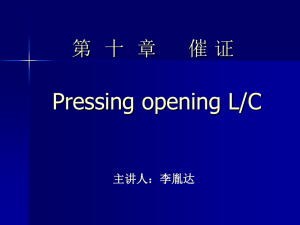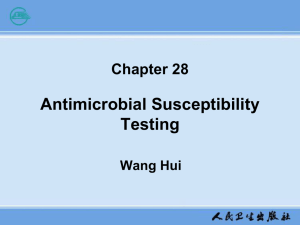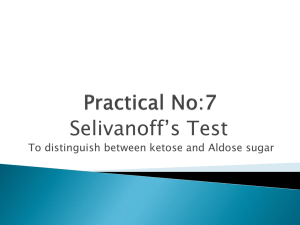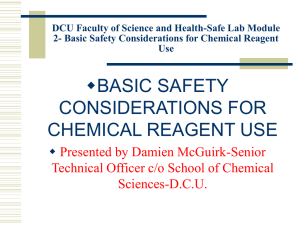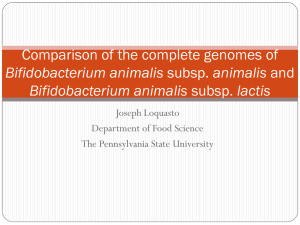Wisconsin AST Training 2012
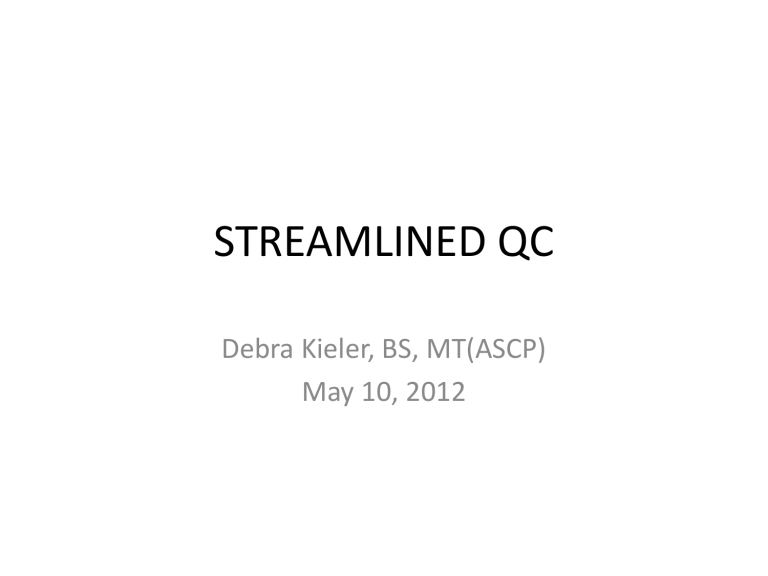
STREAMLINED QC
Debra Kieler, BS, MT(ASCP)
May 10, 2012
• Southwest Health Center (SHC)-Platteville, WI
• 25 bed critical access hospital, 84 bed nursing home, and 10 bed inpatient adult psychiatric unit
• Hospital lab staffed 24/7/366 by MLT, MT, and MLS personnel
• Microbiology mainly 0600 to 1800 daily
• ID and susceptibilities of aerobic gram negative and gram positive organisms
• Biomerieux Vitek 2 Compact-purchased in 2006
• Gram negative ID and AST cards
• Gram positive ID and AST cards
• ID and AST reporting with Vitek 2 - 2007
• AST/MIC QC-each new lot of cards/shipment and weekly thereafter
• AST-GP67-gram positive organisms
– Staph aureus-ATCC 29213
– Staph aureus-ATCC BAA1026
– Staph aureus-ATCC BAA 977
– Staph aureus-ATCC BAA 976
– Enterococcus faecalis-ATCC 51299
– Enterococcus faecalis-ATCC 29212
• AST-GN45-gram negative organisms
– E. coli ATCC 25922
– E. coli ATCC 35218
– Pseudomonas aeruginosa ATCC 27853
– Klebsiella pneumoniae ATCC 700603
• This is the minimum suggested QC for susceptibility testing
• NO streamlining AST QC on Vitek 2 Compact
• But, streamline qc in micro with ID cards for gram negative and gram positive organisms or
GN and GP cards, is possible
• CLSI M50-A Volume 28, No. 23- Quality
Control for Commercial Microbial
Identification Systems; Approved Guideline document
• Biomerieux (BMX) communications
• MIS-Microbial Identification Systems
• MIS-test systems that utilize multiple substrates and/or reagents to identify aerobic or anaerobic bacteria, yeast, moulds, or yeast-like algae grown from culture
• CLIA regulations effective 9/1/1992-QC of a commercial
MIS-every reagent/and/or substrate of each batch, lot number, and shipment when prepared or opened for positive and negative reactivity (42CFR 493.1256); interpretive guidelines (42CFR 493.1261) also state that the lab must use control organisms to verify positive and negative reactivity.
• Ongoing QC testing validates that the MIS continues to perform acceptably throughout its use
• Satisfy CLIA for MIS-extensive QC testing even though the frequency of failures is low; retesting that is of questionable value
• 2005-ASM survey showed real product failure was extremely rare; test reactions of specific substrates rather than all substrates; use key indicator strains; detect degradation of labile reagents and/or substrates
• Not all manufacturers provide this-these systems
must follow comprehensive CLIA QC requirements
• STREAMLINED QC-the reduction of QC for a commercial MIS as compared to the requirements in the CLIA regulations
• NOTE: The manufacturer of the MIS will specify the key indicator strains and reagents/substrates to be tested; provide the expected
QC results based on historical data and ongoing QA programs at the site of manufacture. The lab user MAY ADD but MAY NOT
DECREASE the number of specific QC organisms and/or reagents/substrates to be tested and reviewed as recommended by the manufacturer for each lot and shipment. Implementation of
Streamlined QC by the user can only occur after the user has verified the performance of the test system in use.
• Key roles-Manufacturer, Distributor, User
• MANUFACTURER
• Follow quality system standards and regulations
• Provide adequate instructions for use
• Selection of QC organisms appropriate for their MISs
• Acceptance criteria for QC testing
• Explain why strains were selected
• Provide statement of compliance with ISO 13485 and QSRs to the user
• Maintain complaint files
• Investigate, document, and monitor complaints to determine if the MIS still meets performance characteristics
• DISTRIBUTOR
• Comply with manufacturer’s specs for MIS storage and handling before and during delivery to the user
• Maintain documentation that verifies compliance-available to manufacturer and user if requested
• Communicate user complaints to the manufacturer
• USER
• Storage and handling on receipt and before testing is followed
• Staff –qualified, trained, and competent to use MIS
• Retain/follow current technical information/product insert
• Document all MIS QC activities and corrective action
• Comply with all regulations for testing and retaining documents-local, state, and federal requirements
Criteria for Initiation of Streamlined QC
Verification of performance-CLIA-42 CFR 493
1253(b)-been conducted?
Performing comprehensive CLIA QC of each reagent/substrate?
Under CLIA, verification study required after
9/1/92-documentation of study conducted
Before 9/1/92-if verification study not done or no documentation of verification after this date but has been doing comprehensive CLIA QC since 1992 on an ongoing basis, historical review of its QC meets qualification
• If a lab has not conducted a verification study and has not been performing comprehensive
CLIA QC, it does not qualify for streamlined
QC until it has documentation that it has met one of these criteria.
A commercial MIS that is modified by the user does not qualify for streamlined QC either.
INITIAL QUALIFICATION
1) Maintain current documentation of manufacturer’s conformance with ISO 13485 and QSR requirements
2) Meet ONE of the following: a) If verification study performed and performance specifications comparable to the manufacturer-
STREAMLINED QC MAY BE DONE IMMEDIATELY
(Documentation of the verification study must be available) b) If verification study not performed or lacking required documentation but comprehensive QC has been performed, user may conduct and document a historical review of QC performance as follows:
i.
Review QC performance for at least 3 consecutive lot numbers of the MIS from 3 different shipments that span at least 3 consecutive seasons to assess seasonal variation of shipping conditions.
ii.
QC testing must be performed using positive and negative controls for each reagent and/or substrate according to the manufacturer’s instructions.
iii. Performance shall be considered satisfactory and the user may initiate streamlined QC if 95% of the reagent/substrate results are within the results specified by the manufacturer. If the QC meets the 95% threshold, but the same reagent/substrate fails repeatedly, it may indicate a problem. These results should be further evaluated.
iv. If the user has insufficient data or unexpected QC results occur, consult CLIA regs before proceeding.
STREAMLINING GP CARD QC AT SHC
• GP CARD QC initially (2006 to 2011)
• Enterococcus casseliflavus
• Kocuria kristianae
• Listeria monocytogenes
• Staph aureus spp.aureus
• Staph saprophyticus
• Staph scuiri
• Strep equi ssp.zooepidemicus
• Strep thermophilus
ATCC 700327
ATCC BAA -752
ATCC BAA -751
ATCC 29213
ATCC BAA -750
ATCC 29061
ATCC 43079
ATCC 19258
• Shipment 1- 10/2006 to 08/2007
• Shipment 2- 08/2007 to 01/2009
• Shipment 3-01/2009 to 07/2010
• Shipment 4-07/2010 to 12/2011
• All expected positive, negative, or variable results had to be obtained
• Any out-of- control results had to be repeated until satisfactory
• 43 biochemicals tested per qc organism
• #1, #2, and #3 shipments performed as expected
• #4 shipment had 0129R (-) vs. (+) on 19258 and AspA (-) vs. (+) on 700327
• Repeat testing produced (+) results as expected
• July, 2009 - BMX customer letter informed us of organisms selected for new streamlined qc and new comprehensive qc requirements so we could modify our system per new CLSI M50-A.
• Enterococcus casseliflavus ATCC 700327
• Strep thermophilus ATCC 19258
• These QC organisms were already being used previously so in stock here.
• We were ready to start in Dec., 2011
• Documentation that BMX complies with ISO 13485 and QSR-yes
• Verification study-no
• Comprehensive QC –yes (Three consecutive lot numbers; three different shipments; three consecutive seasons)
• QC testing using positive and negative on each reagent/substrate-yes
• 95% of the reagent/substrate with results specified by BMX-yes
• E. casseliflavus (700327) and Strep thermophilus (19258)-yes
• All reactions as expected-yes
• INITIAL QUALIFICATION HAS BEEN MET-12/2011
BMX changed QC organisms requirements- 11 or 12/2011
Staph saprophyticus (ATCC BAA-750 ) replaced Strep thermophilus (ATCC 19258).
CONTINUED QUALIFICATION-12/2011 and beyond
• Maintain current documentation of manufacturer’s conformance to QSR requirements
• Maintain documentation of verification study or historical QC review
• Test all key indicator strains with each batch, lot number, and shipment
• Perform testing according to manufacturer’s instructions
• Monitor and document streamlined QC performance
• Investigate and resolve any QC failures
• Report QC failures to the manufacturer and distributor
STREAMLINING GN CARD QC AT SHC
• GN CARD QC initially (2006-2010)
Acinetobacter baumannii
Enterobacter cloacae
Klebsiella oxytoca
Ochrobactrum anthropi
Proteus vulgaris
Shigella sonnei
Stenotrophomonas maltophilia
ATCC BAA-747
ATCC 700323
ATCC 700324
ATCC BAA-749
ATCC 6380
ATCC 25931
ATCC 17666
Shipment 1-10/2006 to 05/2007 Shipment 5- 08/2008 to 03/2009
Shipment 2- 05/2007 to 08/2007 Shipment 6- 03/2009 to 05/2009
Shipment 3- 08/2007 to 03/2008 Shipment 7- 05/2009 to 10/2009
Shipment 4- 03/2008 to 08/2008 Shipment 8- 10/2009 to 04/2010
• All expected +, -, or v results had to be obtained
• Any out-of-control results had to be repeated until correct
• 47 biochemicals tested per organism
• Shipment 1-1 failure; repeat ok
• Shipment 2-8 failures; repeats ok
• Shipment 3-6 failures; repeats ok
• Shipment 4-1 failure; repeat ok
• Shipment 5-2 failures; repeats ok
• Shipment 6- 1 failure; repeat ok
• Shipment 7- all ok
• Shipment 8- 1 failure; repeat ok
• Shipment 9- 04/2010
• Ochrobactrum anthropi - BAA-749 proved to be a challenge even if it was
April Fool’s Day. TyrA and AGLU failed repeatedly; we even enlisted BMX’s help and ended up substituting an alternate organism to obtain the results for TyrA and AGLU to have the correct reactions expected in comprehensive qc. In 08/2010-BMX changed the expected value from + to v for AGLU.
• WE WERE EXTREMELY MOTIVATED TO GO TO STREAMLINING
QC ON SHIPMENT 10!
Shipment 10- 10/2010
• July, 2009-BMX customer letter informed us of organisms selected for new streamlined qc and new comprehensive qc requirements so we could modify our system per new CLSI
M50-A.
• Enterobacter hormaechei
• (formerly Enterobacter cloacae)
ATCC 700323
• Stenotrophomonas maltophilia ATCC 17666
• These QC organisms were already being used previously so in stock here.
• We were ready to start in Oct., 2010
• Documentation that BMX complies with ISO 13485 and QSR-yes
• Verification study-no
• Comprehensive qc-yes (Three consecutive lot numbers; three different shipments; three consecutive seasons)
• QC testing using positive and negative on each reagent/substrate-yes
• 95% of the reagent/substrate with results specified by BMX-yes
• Enterobacter hormaechei (700323) and Stenotrophomonas maltophilia
(17666)-yes
• All reactions as expected-yes
• INITIAL QUALIFICATION HAS BEEN MET-10/2010
CONTINUED QUALIFICATION-10/2010 and beyond
• Maintain current documentation of manufacturer’s conformance to QSR requirements-yes
• Maintain documentation of verification study or historical QC review-yes
• Test all key indicator strains with each batch, lot number, and shipment-yes
• Perform testing according to manufacturer’s instructions-yes
• Monitor and document streamlined QC performance-yes
• Investigate and resolve any QC failures
• Report QC failures to the manufacturer and distributor
• Streamlined QC -10/10 to now
• Shipments received 10/10, 07/11, and 02/12
• All shipments performed as expected with no failures
• Streamlined QC has proven to save time and money at SHC!
Questions?
• Contact Debra Kieler
Email at andrewsg@southwesthealth.org
Phone at (608) 342-4760
Fax at (608) 342-5094

